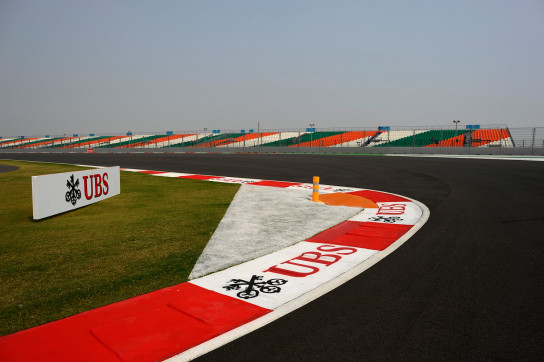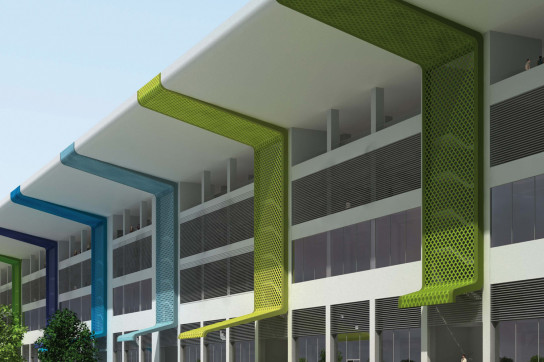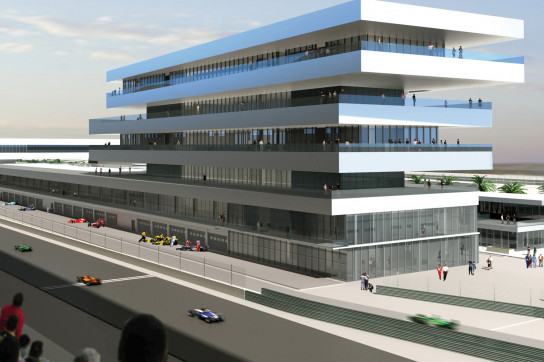Buddh International Circuit
Circuit Overview
The Buddh International Circuit (Hindi: बुद्ध अन्तरराष्ट्रीय परिपथ) was the first circuit to bring international motorsport to India, bursting onto the scene as the host of the Formula One Indian Grand Prix in 2011.
Originally known during planning and development as the Jaypee Group Circuit or the Jaypee International Circuit after the circuit's owners, the gained it's current name at inauguration, in recognition of the area where the racetrack is situated – Gautam Buddh Nagar district (also known as Greater Noida).
Designed by Hermann Tilke, the track has been largely well-received by the drivers and looked set to firmly establish India on the international motorsport calendar. Sadly, a tax dispute with the Government of Uttar Pradesh meant that Formula One's stay was all too brief; after two more races, the Grand Prix was suspended for 2014 and ultimately dropped from the calendar altogether.
With its global reputation tarnished, the circuit has subsequently seen it's rather lavish facilities being rather under-utilised in the intervening years, with general testing, track days and national level racing being only occasional visitors. For 2023, however, world class events returned with the MotoGP World Championships holding a successful inaugural Indian Grand Prix.
Circuit History
Interest in Formula One in India had blossomed along with the career trajectories of Narain Karthikeyan and Karun Chandhok, alongside entrepreneur Vijay Mallya's ownership of the Force India team. With a population of 1.2 billion and a growing middle class eager to spend their money, India was a prime target for Bernie Ecclestone in his quest to expand the Formula One circus into new Asian markets.
The journey to creating the country's first purpose-built Formula Circuit was somewhat tortuous, however. As early as 1997, talk began about holding a race in Calcutta but this came to nothing. By 2003 attention switched to a site near Bangalore airport, though this too came to nought. More promising was a plan to build a track near to the airport in Hyderabad on land set aside by the chief minister of the state of Andhra Pradesh, which soon switched to a location outside the city with the signing of a seven-year agreement to hold the race, starting in 2007.
Despite this promising development, other rival bids started to muddy the water, with Mumbai showing interest from early 2004. By the end of the year, the Government of Andhra Pradesh changed its mind about spending public money on motor racing and the deal fell through.
Fast forward to 2007 and a total of five sites around the country were being considered. It finally took the involvement of the Indian Olympic Association, who signed a deal with Ecclestone to build the circuit in Greater Noida, outside New Delhi, with funding entirely from the private sector. The first race for the new facility in Greater Noida, Uttar Pradesh, was slated to take place in 2009.
Circuit set in a sporting city
The site chosen for the circuit was a new development near New Dehli, called the Jaypee Sports City. India's first planned city developed and aimed for sports, it spreads over 5,000 acres and includes homes, leisure facilities and sporting stadia including a golf course and equestrian centre. The whole development sits alongside the Yamuna Expressway, a new road being built to connect India’s capital New Delhi with the country’s biggest tourist destination, the Taj Mahal, in the city of Agra.
Construction on the new facility (penned almost inevitably by favoured F1 circuit designer Hermann Tilke) was due to start in October 2008. Complications soon set in however, as the effects of the global financial crash meant that the deal to buy the land was much delayed. Scheduled dates for the race were postponed first to 2010 and then finally pushed back to 2011.
Work to build the facility was carried out under the supervision of Jaiprakash Associates Ltd, part of the Jaypee Group industrial conglomerate which has bankrolled the whole development. The facility, which is spread over an area of 874 acres, cost around $400 million to build, and includes seating for around 110,000 spectators, with the potential to increase capacity to 200,000 in the future. The track surface includes asphalt and aggregate specially shipped in from England.
Eventually, the circuit began to emerge, albeit with a considerable rush to complete the facilities ahead of its debut race, not helped when the original December date was pulled forward by several months due to complications with scheduling the Bahrain Grand Prix.
It all meant that when the F1 circus finally arrived in October 2011, it found the circuit still showing the finishing touches of construction, with the major work having finished only two weeks previously and much fresh paint still in evidence. The teams reported several issues with construction, including power outages, some infrastructure being incomplete and a colony of bats living in the pit building. Despite these issues, the circuit itself was considered a success.
Layout draws praise from the drivers
The finished circuit covers 3.192 miles, and includes 16 turns with some noticeable changes in elevation. It was designed with feedback from drivers and teams alike, which resulted in the removal of a planned hairpin and the widening of the layout at Turn 3 to allow different lines to be taken in a bid to improve overtaking opportunities.
One of the outstanding features of layout is the banked multi-apex turn 10–11–12 sequence, which has drawn comparison with another Tilke-creation, the fast Turn 8 at Istanbul Park. Unlike it's Turkish forebear, the Buddh complex runs in a clockwise direction and tightens on exit. Overall, it helps showcase the enormous speed and grip of modern F1 machinery.
Other features include a very long main straight; at 1.06 km (1,159.2 yd) this is among the longest in F1 and helps set up a key overtaking opportunity. The pitlane too is among the longest on the F1 calendar at more than 600 metres, creating headaches for the team strategists given the increase length of time taken for pitstops.
It was generally been well-received by the Formula One drivers with the fast, flowing sections between turns five and 15 in particular drawing favourable comparisons and proving a challenge to drive consistently on the limit.
"Most modern tracks have a very similar feel; you find that the same driving style and rhythm suits them all. But the Buddh International Circuit is different: it has more in common with a great track like Spa than it does with any number of the more modern places we visit."
Vettel proves the master
In the three F1 events that took place in 2011, 2012 and 2013, Red Bull Racing's Sebastian Vettel proved the master, sweeping to victory on each occasion. Indeed, he won all three races from pole position and was so dominant in the first two events, that it took until the third edition for anyone else to even lead a lap (and even then, this only came due to pit strategy).
The major talking point in the 2011 was the clash between McLaren's Lewis Hamilton and Ferrari's Felipe Massa, for which Mass received a drive through penalty. Vettel completed his dominance with fastest lap, the first time he had completed a weekend clean-sweep of accolades.
He was no less dominant in 2012, again taking pole and never being headed in the race, though McLaren's Jenson Button prevented another clean sweep, setting fastest lap of the race. Prior to the weekend, ultrasonic devices were installed around the circuit in a bid to avoid a repeat of the situation from the previous year, when several sessions were interrupted by stray dogs entering the circuit. The crowd figures were down on the opening event's numbers; with a declared 65,000 ticket holders, some 30,000 less than the previous year.
It was no surprise that Sebastian Vettel's winning streak continued in 2013, with the victory in India helping secure the championships for both himself and Red Bull Racing. It would prove the final Formula One event at the circuit, though there were some signs of the trouble to come in the lead up to the race when the organisers of the race, Jaypee Sports International, attended a court hearing on a dispute over unpaid entertainment taxes from the previous running of the Grand Prix. The case was eventually set for the week after the race, thereby ending speculation that the Grand Prix would be cancelled.
Bureaucratic issues call time on F1
Sadly, the goodwill towards India from the racing fraternity was never reciprocated by the local authorities. The court case would eventually go against Jaypee Sports International, with the ruling backing the Uttar Pradesh Government's assertion that Formula One was primarily entertainment. It meant that customs fees for imported components including engines, tyres and fuel were not waived, while tax exemptions given to sporting events were not offered to the organisers.
Formula One deemed this too big a hurdle to overcome and, with Jaypee set to take a massive financial hit, it was inevitable that the 2014 event was cancelled. The additional taxes also meant that Jaypee was prevented from paying its fees to Formula One in full, so it was no surprise that the 2015 and subsequent calendars did not feature the race.
Further complications came in 2017, when the Supreme Court of India ruled that taxes were also due from Formula One itself, despite the contract not originally requiring it. A total of $14.8 million was set aside by Formula One's new owners, Liberty Media, to settle the bill.
No doubt influenced by these developments, other categories also stayed away from the circuit, with planned races for the FIA GT World Championship and FIM World Superbikes both failing to materialise.
All of this background meant that Buddh International Circuit looked likely to have lost any chance of hosting major international motorsport for good, pending a change of heart from the local government. It was a bruising experience for all involved, not least for the Jaypee Group, which has been left with considerable debts. Despite initially insisting that it would retain the circuit with no plans to either close it or sell it off, the Jaypee Group was eventually forced to hand over ownership to the Yamuna Expressway Industrial Development Authority (YEIDA) when it was unable to meet payment obligations. Jaypee does, however, remain responsible for maintaining the facility.
The circuit remains fully operational and maintained to national racing standards. Visits by the JK Tyre National Racing Championship have been the headline events in recent years, alongside a truck racing event in 2017. During the early part of the coronvirus pandemic, the circuit also opened its doors to help shelter the exodus of migrant workers from the large cities.
MotoGP set to fill the headline slot
It took until September 2022 for another promoter to be ready to organise an international motorsport event at the track. MotoGP organiser Dorna Sports announced that it had come to agreement with promoter Fairstreet Sports to host an Indian Grand Prix the following year. “We have a lot of fans in India and we’re excited to be able to bring the sport to them," said Dorna CEO Carmelo Ezpeleta. “India is also a key market for the motorcycle industry and therefore, by extension, for MotoGP as the pinnacle of the two-wheeled world.
“We very much look forward to racing at Buddh International Circuit and can’t wait to welcome the fans through the gates to see this incredible sport in person."
Given its pedigree, it was expected that only minor modifications would be required to bring the track to FIM Grade A standards. A visit in summer 2023 by FIM inspectors saw work to resurface part of the back straight requested, along with modifications to some run-off areas and gravel traps. In addition, the insertion of the Penalty Loop was required, likely to involve a change to Turn 3. Air fences will be required at certain corners and are expected to be imported by Dorna for the race.
In total, the changes are expected to cost around £3-4 million and would ordinarily be relatively straightforward to implement. However, the complex legal situation surrounding the ownership of the venue has proved problematic, with Fairstreet unclear as to who would be responsible for making the changes.
According to the Times of India, Fairstreet Sports COO Pushkar Nath Srivastava has written to YEIDA to to establish whether it would carry out the works. “We have been trying to find out the way to get the work done on time and that’s why we submitted the letter,” Srivastava was quoted as saying. “We have learned that Jaypee Group is still maintaining the circuit while YEIDA still owns it. As it is private property, we have asked whether YEIDA could do the repair works or if we can do it on their behalf."
Government funding allows upgrades
The impasse was finally resolved when the Noida, Greater Noida and YEIDA authorities allocated 10 million rupees (around £950,000) for the track modifications. Then, in early September 2023, the Uttar Pradesh government also set aside 80 million rupees (equivalent to around £750,000), directing YEIDA to take effective measures to ensure that the event was conducted with "discipline and grandeur". With the funding and logistics issues now sorted, there was a hurried effort to ensure everything would be ready in time for the arrival of the MotoGP stars.
It seemed a huge undertaking to many, with doubts expressed by the riders who remained concerned for their safety. The situation wasn't helped when visa issues meant riders, team personnel and media were delayed in getting into the country. When they did finally arrive, they found that the changes requested had been accommodated and were pleasantly surprised at the track's condition. Pol Espagaro was among those admitting fears had been overblown: “Honestly, I think we were a little bit too hard, before coming here and seeing what it really was. I think it's much better than we all expected, I believe. About safety, for sure there are some things that can be improved. But I believe in all the racetracks in the world there are places where we'd like to improve."
After their first laps, the MotoGP riders were pretty unanimous in their praise for the track, with the undulations, long straights and flowing corner sequences drawing particular acclaim. Jorge Martin even went as far as suggesting it had become a contender for his favourite track on the calendar.
Monsoon rains in some of the practice sessions caused stoppages and delays and the dusty nature of the track also caused problems, with 23 riders across all classes coming a cropper at Turn 1. The races themselves were noted for the extreme hot temperatures and high humidity, which was particularly punishing for the top class riders. It also prompted concerns about tyre life and race organisers soon decided to reduce race distances as a precaution. The event tied with Le Mans as having the most crashes across the weekend (79 across all classes) during the 2023 season.
Despite these teething issues and a relatively modest crowd (110,000 across three days, the lowest of the season), it was almost universally felt to be a success. With more time to solve the remaining issues, additional promotion and a greater belief among local fans that the race really is going to take place, the ingredients are there for the Indian Grand Prix to become a real seasonal highlight in years to come.
Jump onboard
Circuit info
- Buddh International Circuit, Jaypee Sports City, Sector-25, YEIDA, Along Yamuna Expressway, Gautam Budhh Nagar, UP, India
- +91 120 4429498 / +91 120 4429499
- Email the circuit
- Official website
Rate This Circuit
Votes: 6152
Gallery
The latest images from Buddh International Circuit.







Plan a visit
Get your race tickets!
Brought to you with: 
We've teamed up with Motorsports Tickets to bring you the best deals for Formula One, MotoGP, Le Mans and more.

























